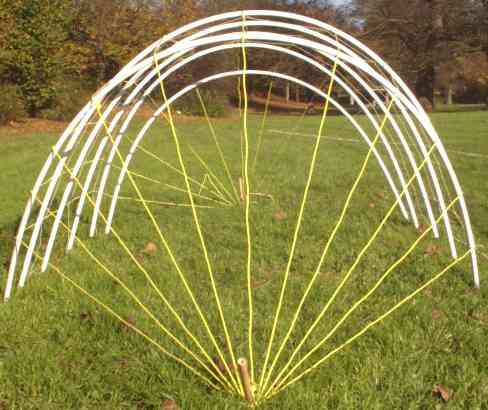
Polytunnels
Woven Polytunnels

Model polytunnel - made using triaxial weaving
In theory it's possible to combine the roles of structural
support and support for the polythene. This page explores
configurations that offer more support for the polythene
than conventional designs.
Triaxial weaving is one possibility in this context.
Triaxial weave is light, resiliant, strong in all
directions, very resistant to shearing forces - and yet
still easy to construct.
Model triaxial Polytunnel
I constructed a model triaxial weave polytunnel:

Model polytunnel
I used one of the flimsiest materials I had available to
me.
The polytunnel was made with struts of wood measuring 1200mm
x 8mm x 1.5mm.
I obtained these struts by dismantling a window blind.
These were joined together in groups of two (vertical
struts) or four (horizontal struts).

Close up - showing strut joins and weave detail
Struts were joined together with 6mm internal diameter PVC
tubing.
There was no need to cut the struts - except for a
few at each end of the structure.
Construction
The structure is assembled while lying flat on the ground.
First the left-slanting struts are positioned, then the right-slanting
struts are positioned on top of them. Finally, the horizontal struts
are woven between them.
Even the polythene (and any insulation) is put in place when
the structure is lying flat. It is held at the edges using
pegs.
Then the structure is erected. Erection consists of
immobilising one edge - and lifting the center of the tunnel
slightly.
Then the far edge of the tunnel is progressively moved
towards the immobilised edge, keeping it pinned down at all
times.
Ropes could also be used to pull on the walls of the tunnel
during the erection process.
Internal support
Larger polytunnels would need internal support if they are to
resist cross-winds. Such supports are not illustrated here.
Additional structural elements
It is often seen as desirable for polytunnels to have a
hexagonal cross-section - i.e. vertical walls, and a
somewhat pointed roof. This gives a bit more space at the
edges - and reduces the chance of water and snow settling on
the roof.
To allow this, ropes could profitably be used internally at
the roof ridge - and at either side; at the "eaves" of the
structure - to create areas of greater curvature, using
tension.
Rope makes sense in this context - since it is very strong,
very cheap - and very easy to work with.
Roof ridge
To further reduce the chance of water and snow settling on
the roof, a single long tube can be added at the top of the
structure, lashed on to the top.
Insulation
A second layer of polythene is the most obvious way of
insulating a transparent polytunnel. To do this, a simple
way is to hang some light and cheap horizontal struts from
the structure's ridge pole - and then add a second layer of
polythene over the top.
Unfortunately, insulation seems likely to increase the
persistence of condensation inside the structure - which
will reflect off some of the incident light.
Strut angles
Conventional polytunnel designs have few structural
elements that traverse the length of the polytunnel.
It seems little strength in that direction is needed - since
the ground provides good structural support in that
direction.
So - a possibility is distorting the triaxial weave to
increase the extent to which the vertical struts are
vertical - and decrease the number of horizontal struts.
While some adjustment in that direction may be
worthwhile, my perception is that it doesn't make
much sense to attempt to distort the structure very
far in this direction. The horizontal struts stabilise the
structure by weaving it together - and support the polythene -
their role is thus suprisingly important.
Rectangular weave
Rectangular (rather than triaxial) woven polytunnels are
also possible.
This page illustrates
the possible rectangular weave designs.
The end of the polytunnel
One possible way of finishing such tunnels would be to throw in
three pentagons - and continue the triaxial weave right to the
ground. This might waste a little growing space at either end -
but that's probably not a critical concern.
The best way of ending this sort of polytunnel - while
wasting as little space as possible and still leaving space
for an entrance - is likely to be the subject of future
work.
See the triaxial sphere
page for more about the issue.
Tim Tyler |
Contact |
http://hexdome.com/
|